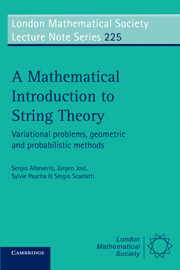We recall that in section II.4 we replaced the integration over the embeddings X by the determinant of the Laplace operator, and that in section II.5 we implemented the Faddeev–Popov procedure to discard the integration over D0 (the group of smooth diffeomorphisms homotopic to the identity) by introducing the Faddeev–Popov determinant, which essentially coincides with the determinant of the operator Pg given by (1.4.10). In section II.6, we interpreted the integration over the conformal deformations in terms of a family of Liouville measures indexed by Teichmüller parameters. In this section we shall investigate the integration over Teichmüller space; the measure on the latter is given by the Weil–Petersson metric. There are many articles concerning a “direct” description of the Polyakov measure in critical dimension, e.g. [BJ], [BK], [BM], but these do not discuss, as we did, its derivation from functional integrals considered for all d.
As before, we let Tp,k be the Teichmüller space of surfaces of genus p with k boundaries. As discussed in section 1.7, it can be considered as a totally real subspace of Tq, with q = 2p + k − 1, the genus of the Schottky double. We recall that the cotangent space of Tp,k is given by the holomorphic quadratic differentials which are real on the boundary, and that on this space we have the Weil–Petersson metric. Complexifying, we obtain the space of holomorphic quadratic differentials on closed surfaces of genus q, and these differentials vary holomorphically with the conformal structure of the surface.
